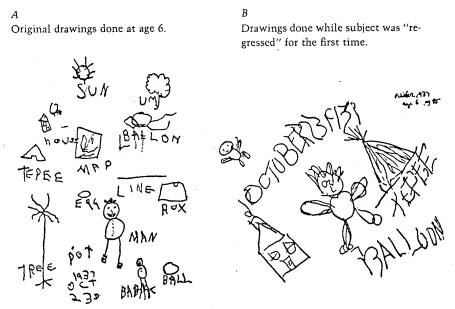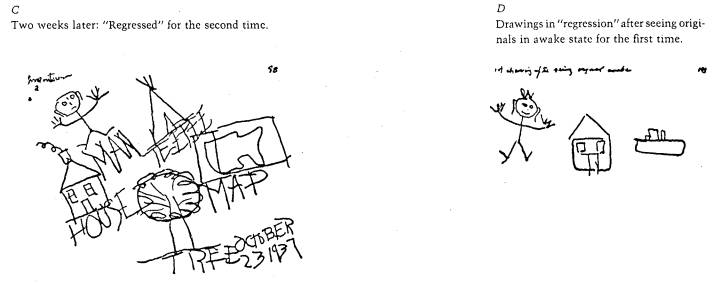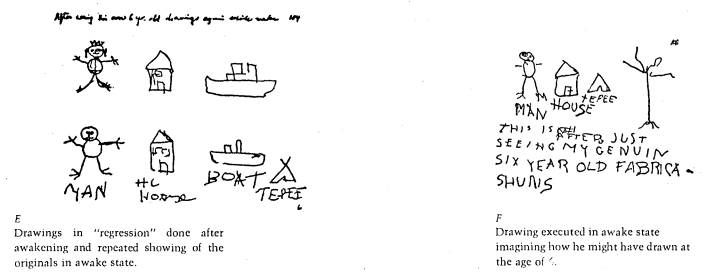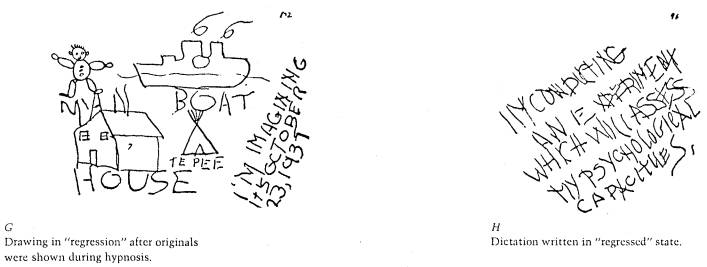
Orne, M. T. Hypnosis. In G. Lindzey, C. Hall, & R. F. Thompson (Eds.), Psychology. New York: Worth Publishers, 1975. Pp.150-154
Institution of Pennsylvania Hospital and University of Pennsylvania
Under hypnosis, some subjects seem able to experience the world as it is suggested to them -- they see, hear and feel what is told to them, apparently oblivious to other stimuli; they can forget what has happened or remember what has not occurred.
Ever since this phenomenon was first described by the Marquis de Puysegur, one of Mesmer's students, controversy has persisted about the effects, the nature, and even the very existence of hypnosis.
Thanks largely to the way hypnosis has been depicted in fiction and presented by stage magicians, most people think of it as a means of controlling behavior. However, systematic studies have shown that all items of behavior carried out by deeply hypnotized individuals can also be elicited from nonhypnotized control groups. I often illustrate this point in the context of a lecture by asking students to carry out a number of mildly embarrassing, nonsensical requests such as giving me their wallet, taking off their left shoe, and so on. After these tasks have been carried out, I asked if they had been hypnotized, and they correctly answer, "Of course not." I can then point out to observers that if these same students had been hypnotized first and then carried out the very same behaviors, they would have said, "Oh, they did that because they were hypnotized." Of course, the students had merely been cooperative, assuming -- correctly, I hope -- that some legitimate reason for these peculiar requests would ultimately emerge.
If the subject's willingness to do what is demanded of him does not characterize hypnosis, what does? Again try a simple experiment. Consider the hippopotamus -- no doubt you have seen one at the zoo. Think about the hippopotamus. Now try to forget it. Try very hard. You will note that the harder you try,, the less likely you are to succeed. However, a deeply hypnotized individual can forget with ease, although most of us usually find it almost impossible to "will" forgetting. What characterizes hypnosis, then, is not the hypnotist's control over a subject's behavior but rather the subject's potential to alter his or her subjective experiences in accordance with the suggestions of the hypnotist. What makes hypnosis unusual is not the behaviors that subjects can be induced to carry out but rather the changes in subjective experience that seem to be reflected by these behaviors.
Let's look at one of the many striking and fascinating hypnotic phenomena -- suggested age regression. A deeply hypnotized person, told that he is 6 years old, will begin to behave like a 6-year-old. Typically, he will print in an unmistakably childlike fashion rather than write. His tone of voice, his mien, and even his movements will resemble a child's. His performance is so convincing that many observers readily accept the regression as genuine. Because of age regression's implications for cognitive psychology in general and memory and development in particular, and because of its clinical importance in psychotherapy, investigators have sought to document this effect in a number of careful studies.
Among the most compelling findings were studies showing that the Babinski reflex (extension and fanning of the toes in response to stimulation of the sole of the foot), which is characteristic of early infancy, could be reinstated in subjects who were age-regressed to that period (Gildro-Frank & Bowers-Buch, 1948) and studies that showed performance on both intelligence tests and projective tests (such as the Rorschach) characteristic of actual children at the age to which hypnotized subjects

150
151 HYPNOSIS
had been regressed (Spiegel, Shor, & Fischman, 1945). A particularly influential study (Reiff & Scheerer, 1959) used Piaget-type tasks (for example, matching the lengths of two lines; see Chapter 14) to assess the level of cognitive development in age-regressed subjects and employed, as a comparison group, others who were simply instructed to play-act. These experiments showed that hypnotized individuals could perform the Piaget-type tasks as actual children would perform them, while role-players could not. Perhaps the simplest and therefore most striking demonstration involved regressing subjects back to their birthdays at ages 10, 7, and 4, and asking them the day of the week. Hypnotized individuals performed at far better than the chance rate on this task, whereas others did not (True, 1949).
These studies seemed to prove that age regression involves almost miraculous changes, suggesting that all information once available to consciousness remains somehow stored and available if we can but learn to unlock the filing system. However, further research, which threw a different light on these findings, illustrates the immense problems confronting the scientist seeking an objective explanation of subjective events. For example, it is true that the Babinski reflex usually reflects either an organic injury in adults or an immature nervous system, but some adults suffering from hysteria display a reaction resembling the Babinski reflex. Furthermore, the subjects in the Gildro-Frank and Bowers-Buch study were medical students and nurses whose training gave them ample opportunity to learn how and at what age the Babinski reflex changes. Because of the erroneous assumption that the change in the Babinski reflex was necessarily beyond an individual's volitional control, the experimenters had not employed a control group.
The Reiff and Scheerer study was particularly instructive. On closer examination, it became apparent that those experimenters knew which subjects were play acting and the subjects instructed to play-act knew that the experimenters were aware of their status. In an extended replication, a minor but crucial variation of the original Reiff and Scheerer experiment was introduced. In addition to play-acting subjects, another group of unhypnotizable subjects was asked to "fake" hypnosis for a hypnotist who did not know which subjects would be faking. These subjects realized they could succeed in their task of deceiving the hypnotist -- and they did! On the particular tests employed, the performance of the faking subjects was indistinguishable from that of deeply hypnotized individuals. Not only is it likely that Reiff and Scheerer treated subjects they knew to be hypnotized differently from their play-acting controls, but play-acting subjects behaved differently from subjects who were faking for a hypnotist who they knew was unaware of their true status. This difference seems to account for most of the reported findings.
A particularly interesting aspect of the replication was the inclusion of groups of actual children. To everyone's surprise, their behavior was entirely different from that of either the hypnotized subjects or those who were faking (O'Connell, Shor, & Orne, 1970). For example, in a seem-

152 CHAPTER 5 STATES OF AWARENESS

ingly ingenious procedure, Reiff and Scheerer had their subjects make mudpies while they were regressed to age 4. After their hands were caked with mud, the subjects were offered a lollipop, which the experimenter held by the stick. The hypnotized subjects were willing to grasp the candy part with muddy hands while role-players insisted on taking their lollipop by the proper end. In the replication, both the subjects who were faking -- without the experimenter's knowledge -- and the truly hypnotized subjects put their hands on the candy before placing it in their mouths. However, when actual 4-year-old children were tested, they all insisted on taking the lollipop by the stick -- much to the surprise of the experimenters!
The study involving the identification of the day of the week on which the 10th, 7th, and 4th birthdays fell is perhaps the most difficult to understand. Several investigators tried unsuccessfully to replicate it; yet their failure did not explain the reported findings. The answer finally emerged in a personal communication with the author of the original study. He indicated that an editor had shortened his published paper and that it was important that subjects be asked, "Is it Monday?" "Is it Tuesday?" "Is it Wednesday?" Further inquiry revealed that during the experiment, the hypnotist knew the correct answer since he had a perpetual calendar before him. One explanation might be that the experimenter had inadvertently communicated the correct answer to the hypnotized subjects. Further analysis of the published data showed that the subjects while regressed to age 4 reported the day of the week almost as accurately as when they were regressed to age 7. However, checks with real children show that, when asked what day it is, hardly any 4-year-olds can correctly name the day of the week while almost all 7-year-olds can. This strongly supports the likelihood that those original findings had been due to the experimenter's inadvertent bias.
This situation illustrates the issues confronting the investigator hoping to understand hypnosis. First, he is impressed with dramatic effects only to find with truly careful study that the apparent changes are largely illusory or within the behavioral repertoire of normal waking individuals. Not surprisingly, skeptics have from the very beginning raised questions about the reality of hypnosis.
When a nonscientist observes hypnotic age regression and asks if it is real, he is asking two different questions. First, is the subject actually like a child and does he accurately remember events that occurred when he was 6 years old? Second, does the subject really feel like a child? Is he really deluded into thinking he is a child, and not merely "putting me on" and consciously making believe? The answer to the first question is for the most part "no," the hypnotized person's mental processes remain those of an adult. While his memory may be somewhat improved, especially for traumatic, emotionally charged events, it is not otherwise different in kind. However, the answer to the second question is a resounding "yes." The deeply hypnotized subject is deluded; he does at the time believe he is a child; and his behavior cannot be explained as simply conscious play-acting.
It is paradoxical that some of the most compelling evidence for the genuineness of hypnotic age regression emerges from some of the obvious inconsistencies seen in subjects' behavior. For example, an individual regressed to age 6 printed in a typical childlike fashion but in perfect spelling: "I'm conducting an experi-
153 HYPNOSIS

ment which will assess my psychological capacities." Even more dramatic, a German-American subject who spoke English well but who had not learned English by age 6 replied to my question, "Do you speak English?" in his native German, "Nein" (no). When asked, again in English, if he understood any English at all, he reiterated, "Nein." When asked whether his parents spoke English, his answer was " Ja. Damit ich's nicht verstehe." (Yes. So I won't understand). I rephrased the question 10 times in English and each time received an appropriate response in German, clearly indicating that he understood while his verbal assertions maintained that he could not understand. No subject who is play-acting is sufficiently careless or naive not to recognize the blatant inconsistency in such behavior. Indeed, we have observed that in this sense subjects simulating hypnosis do a more "believable" job than those actually hypnotized. Yet this very inconsistency is typical of the hypnotized individual; it is an honest behavioral reflection of altered experiences rather than the consequence of a subject's thinking about how to behave correctly.
While hypnotic age regression cannot miracuously reverse psychological or physiological changes brought about by aging any more than it can cause an individual to shrink in size, it does produce profound experiential changes that often can be useful in the course of psychotherapy. Traumatic events that are so painful they are pushed out of consciousness while still exerting important effects on the individual can be brought to consciousness so that the person can deal with them. Other important therapeutic applications of hypnosis range from controlling pain to mobilizing the patient's motivation to help him accomplish difficult goals.
Research has shown that individuals differ widely in their ability to enter hypnosis. As we noted, the hypnotist does not directly control the subject's behavior; rather, through mechanisms closely related to fantasy and imagery, he can alter the subject's experience. The extent of the subject's response depends more on his desires and skill than on the hypnotist's ability. With a willing subject, hypnosis requires no special technical skill. Certainly, an ability to hypnotize people does not qualify an individual as a therapist. Hypnosis is a technique to be employed by trained therapists. As such, it should be used only by individuals who have broad therapeutic training and are equally competent with other therapies.
Even more important than the present-day therapeutic use of hypnosis may be the lessons hypnosis can teach us about the nature of man. Preeminently, hypnosis illustrates the difficulty inherent in the objective study of subjective events. The investigator needs to avoid both an irrational belief in magic and an equally irrational skepticism that may lead him to deny events merely because he finds them difficult to understand.
Finally, hypnosis is a uniquely human phenomenon that can teach us much about human potentialities. When we can understand adequately why some individuals have the capacity to be hypnotized while others do not, why such simple procedures as hypnotic induction can produce such profound changes, and how imagination can be temporarily stimulated to override sensory experience, we may better understand the mechanisms responsible for much of psychopathology as well as for some of man's artistic achievements.
154 CHAPTER 5 STATES OF AWARENESS
Hypnosis: What Is It?
There is no doubt that a subject under hypnosis behaves differently. Subjects have undergone surgical procedures ranging from tooth extraction to amputation of an arm with no more anesthetic than hypnosis and afterword reported no discomfort or pain, although they exhibit the normal physiological reponses to pain. Is hypnosis a separate state of awareness? We really cannot answer this question yet.